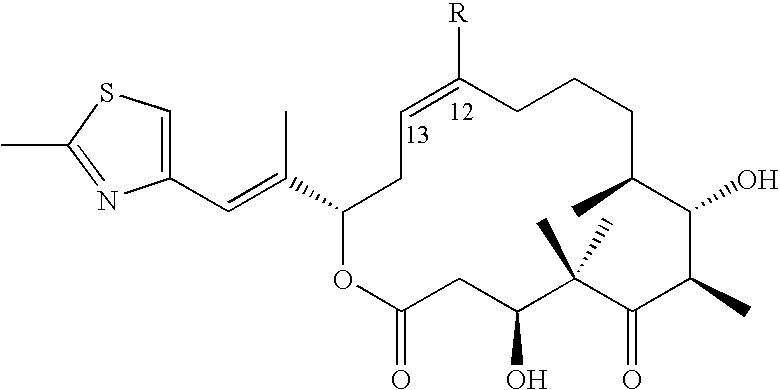Recombinant methods and materials for producing epothilone and epothilone derivatives
a technology of epothilone and derivatives, which is applied in the fields of recombinant methods and materials for producing epothilone and epothilone derivatives, can solve the problems of tedious chemical synthesis of epothilones, time-consuming, expensive, etc., and achieves the effect of facilitating the full-scale pharmaceutical development of epothilones
- Summary
- Abstract
- Description
- Claims
- Application Information
AI Technical Summary
Benefits of technology
Problems solved by technology
Method used
Image
Examples
example 1
DNA Sequencing of Cosmid Clones and Subclones Thereof
[0269]The epothilone producing strain, Sorangium cellulosum SMP44, was grown on a cellulose-containing medium, see Bollag et al., 1995, Cancer Research 55: 2325–2333, incorporated herein by reference, and epothilone production was confirmed by LC / MS analysis of the culture supernatant. Total DNA was prepared from this strain using the procedure described by Jaoua et al., 1992, Plasmid 28: 157–165, incorporated herein by reference. To prepare a cosmid library, S. cellulosum genomic DNA was partially digested with Sau3AI and ligated with BamHI-digested pSupercos (Stratagene). The DNA was packaged in lambda phage as recommended by the manufacturer and the mixture then used to infect E. coli XL1-Blue MR cells. This procedure, yielded approximately 3,000 isolated colonies on LB-ampicillin plates. Because the size of the S. cellulosum genome is estimated to be circa 107 nucleotides, the DNA inserts present among 3000 colonies would corr...
example 2
Construction of a Myxococcus xanthus Expression Vector
[0302]The DNA providing the integration and attachment function of phage Mx8 was inserted into commercially available pACYC184 (New England Biolabs). An ˜2360 bp MfeI-SmaI from plasmid pPLH343, described in Salmi et al., February 1998, J. Bact. 180(3): 614–621, was isolated and ligated to the large EcoRI-XmnI restriction fragment of plasmid pACYC184. The circular DNA thus formed was ˜6 kb in size and called plasmid pKOS35-77.
[0303]Plasmid pKOS35-77 serves as a convenient plasmid for expressing recombinant PKS genes of the invention under the control of the epothilone PKS gene promoter. In one illustrative embodiment, the entire epothilone PKS gene with its homologous promoter is inserted in one or more fragments inks the plasmid to yield an expression vector of the invention.
[0304]The present invention also provides expression vectors in which the recombinant PKS genes of the invention are under the control of a Myxococcus xanthu...
example 3
Construction of a Bacterial Artificial Chromosome (BAC) for Expression of Epothilone in Myxococcus xanthus
[0314]To express the epothilone PKS and modification enzyme genes in a heterologous host to produce epothilones by fermentation, Myxococcus xanthus, which is closely related to Sorangium cellulosum and for which a number of cloning vectors are available, can also be employed in accordance with the methods of the invention. Because both M. xanthus and S. cellulosum are myxobacteria, it is expected that they share common elements of gene expression, translational control, and post translational, modification (if any), thereby enhancing the likelihood that the epo genes from S. cellulosum can be expressed to produce epothilone in M. xanthus. Secondly, M. xanthus has been developed for gene cloning and expression. DNA can be introduced by electroporation, and a number of vectors and genetic markers are available for the introduction of foreign DNA, including those that permit its s...
PUM
| Property | Measurement | Unit |
|---|---|---|
| total volume | aaaaa | aaaaa |
| total volume | aaaaa | aaaaa |
| total volume | aaaaa | aaaaa |
Abstract
Description
Claims
Application Information
 Login to View More
Login to View More - R&D
- Intellectual Property
- Life Sciences
- Materials
- Tech Scout
- Unparalleled Data Quality
- Higher Quality Content
- 60% Fewer Hallucinations
Browse by: Latest US Patents, China's latest patents, Technical Efficacy Thesaurus, Application Domain, Technology Topic, Popular Technical Reports.
© 2025 PatSnap. All rights reserved.Legal|Privacy policy|Modern Slavery Act Transparency Statement|Sitemap|About US| Contact US: help@patsnap.com



